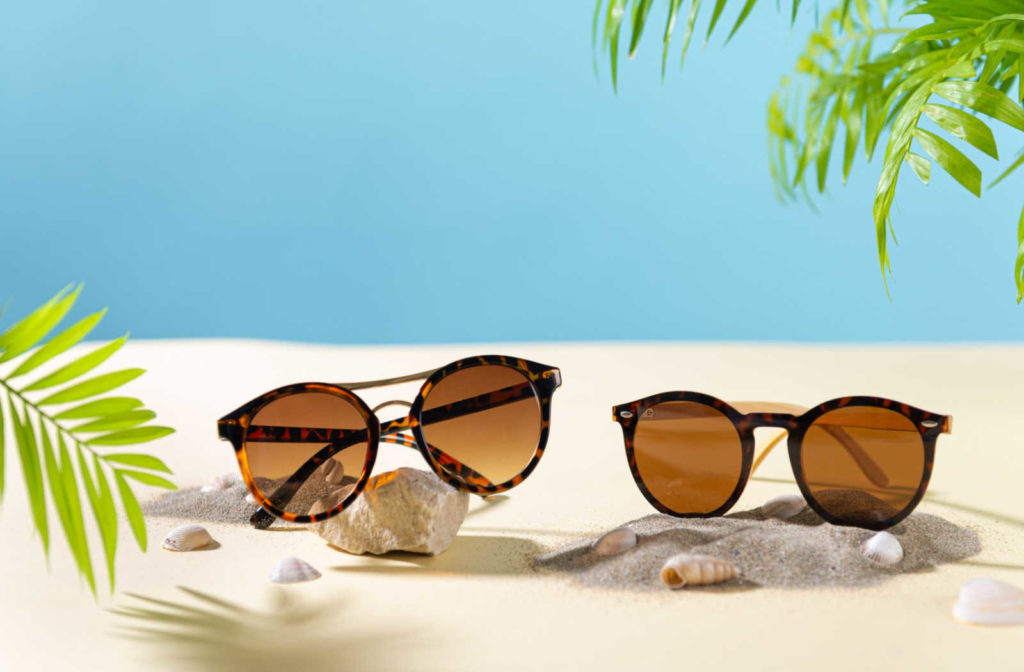How Shades Save Sight
Sunglasses are more than the perfect accessory for a sunny day. In addition to being a fashion choice, your decision to wear sunglasses can help prevent eye diseases. Protecting your eyes from the brightness and billowing dust can also improve visibility and dry eye.
Sunglasses are a simple but effective eye care tool—when you select the right style. So how else can your sunglasses benefit your eye health & vision?
What Is UV Radiation?
UV radiation or ultraviolet light is a form of energy invisible to the human eye. The most common source of UV radiation is sunlight, which includes 3 types of UV rays:
- UVA
- UVB
- UVC
UVA has the longest wavelengths, followed by UVB and then UVC. Shorter wavelengths have more energy, which is why UVC can cause more harm than UVA. Fortunately, the Earth’s atmosphere absorbs all the sun’s UVC and some UVB rays.
While one positive benefit of UV radiation is the production of vitamin D, direct or long-term exposure can increase health risks, including:
- Blinding eye diseases
- Premature aging
- Sunburn
- Skin cancer
UV Exposure & Eye Health
The UV radiation emitted by the sun can be harmful to our health and sight. Although it’s unclear how much exposure is safe, avoiding direct sunlight and wearing UV-blocking sunglasses can protect your eyes.
Some common eye health risks associated with UV radiation include cataracts, eye cancer or growths, macular degeneration, photokeratitis, and solar retinopathy.
Cataracts
A cataract is a cloudy or hazy spot that forms in the eye lens. The lens is typically clear to allow light to pass through. Most cataracts are age-related, affecting half of all Americans age 60 or older. However, eye injuries, conditions, and UV exposure can also lead to cataracts.
Cataract symptoms include:
- Blurry vision
- Difficulty seeing at night
- Poor color vision
- Prescription changes
- Sensitivity to glare or light
Prescription eyeglasses or contact lenses can improve vision with early-stage cataracts. However, when vision is severely impacted, an optometrist may recommend cataract surgery to replace the clouded natural lens with an intraocular lens implant (IOL).
Eye Growths & Pterygium
Constant or long-term sunlight exposure can affect eye tissue, causing abnormal growth such as eye cancers or pterygium. Surfers, fishermen, skiers, farmers, and others who spend long hours exposed to the sun or reflective outdoor environments are at risk.
A pterygium is an abnormal growth on the conjunctiva (covering the white of the eye) and the cornea (transparent front surface of the eye). It can change the appearance of the eye and impact vision in the form of astigmatism.
Macular Degeneration
Macular degeneration is an eye disease affecting the macula tissue at the retina’s center. In the early stages, there can be few symptoms. However, as damage progresses, it can lead to:
- Color vision loss
- Decreased central vision
- Distorted shapes or lines
- Inability to see objects clearly
The 2 forms of macular degeneration, dry and wet, share similar symptoms but are treated differently. Dry macular degeneration has no cure, but there are promising results for slowing vision changes with nutritional supplements. Visit the doctors at LaFerla Family Eyecare for the most effective eyecare supplements for macular degeneration. Wet macular degeneration can be controlled with anti-VEGF injections and laser eye surgery.
Photokeratitis
Photokeratitis, also known as sunburned eyes or snow blindness, is similar to sunburned skin. Snow blindness can develop quickly when UV light is reflected off snow, ice, water, or other reflective surfaces. However, photokeratitis can also develop slowly from prolonged sunlight exposure.
The conditions affect the front layers of the eye, including the conjunctiva (transparent covering over the white of the eye) and the cornea (transparent tissue covering the pupil and iris).
Symptoms depend on how bad the burn is but can include:
- Eye pain
- Headache
- Light sensitivity
- Swelling & redness
- Watery eyes
- Vision changes
Usually, sunburned eyes can heal within a few days. Still, your optometrist may prescribe medication to relieve pain or prevent infection.
Solar Retinopathy
Remember hearing that sage advice to never stare directly at the sun? Solar retinopathy is retina damage caused by prolonged or intense light exposure.
When the eye is overexposed to light, such as staring directly at the sun or viewing a solar eclipse, it can cause temporary or permanent damage. The damage can be cumulative (such as frequently sunbathing) or sudden.
Symptoms can range depending on severity but can include:
- Headache
- Eye pain
- Light sensitivity
- Partial or total vision loss
- Watery eyes
- Vision changes

Sunglasses Tips
While blocking direct sunlight or limiting eye exposure is helpful, not all sunglasses are made equally. When considering safe sunglasses, color does not matter, but size does.
Dark black shades can offer the same protection as neon pink. Checking for 100 percent UV protection or UV absorption up to 400 nm is the only guarantee the lenses block UV radiation. Oversized or wrap-around sunglasses cover more surface area. They can help prevent light from reaching your eye from the sides of your glasses.
Polarized lenses reduce glare and can improve contrast. Although unique colored tints can improve visibility and look neat, it’s not the same as UV protection. Of course, you can find tinted sunglasses with anti-reflective coating that also block UV radiation. Make sure your eyewear checks off all your vision needs first, then consider the fashion statement.
Selecting Your Shades
Looking good and protecting your sight can be simple with the right pair of sunglasses. You can also personalize eyewear with an anti-reflective coating for your shades or prescription eyewear. So you can enjoy the many benefits of a fun day in the sun without risking your eye health.
Talk to your optometry team for advice about sunglasses that offer everything you need, from style to safety. At LaFerla Family Eyecare, we’re committed to helping our patients receive eye services and products suited for their health and comfort. Our optical boutique features inspiring designs and classic favorites.
Book an appointment to learn more about how we can customize your eye care and eyewear.



